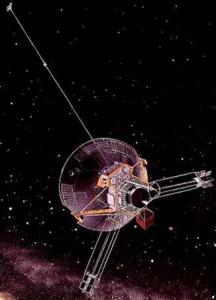Centauri Dreams now returns to its normal publication schedule, after a brief hold to allow the recent post on the creation of an interstellar foundation to receive maximum visibility. The good ideas that came in both through comments as well as e-mail now go to the founding members of the foundation, and as further news develops, I will publish it here. If you would like to make a suggestion about the name of the foundation, feel free to send it either as a comment on the original post or as an e-mail message to me.
But now we move back to research news, and an issue that needs updating. The Pioneeer Anomaly has caught our attention before — both Pioneer spacecraft seem to be slowing down as they depart our Solar System in ways that challenge conventional theory. The Planetary Society’s Pioneer Anomaly Team has launched an effort to recover Pioneer datasets and analyze their contents which has now examined over eleven years of Pioneer 10 data and about four years from Pioneer 11. Further good news is that media for all the Doppler data for the entire span of the Pioneer missions has been collected.
 That this is challenging work should surprise no one who has worked with computers in the past decade. The data formats used for Pioneer are in most cases obsolete and no longer supported by standard software packages. Fortunately, we’re still at a point where these older formats can be decoded, and the team now oversees the analysis of a total of 35 gigabytes containing 110,000 data points from these missions. A separate effort has recovered almost all the original Pioneer telemetry in the Deep Space Network’s Master Data Record format; this combines data about the status of the spacecraft with the results of its scientific measurements.
That this is challenging work should surprise no one who has worked with computers in the past decade. The data formats used for Pioneer are in most cases obsolete and no longer supported by standard software packages. Fortunately, we’re still at a point where these older formats can be decoded, and the team now oversees the analysis of a total of 35 gigabytes containing 110,000 data points from these missions. A separate effort has recovered almost all the original Pioneer telemetry in the Deep Space Network’s Master Data Record format; this combines data about the status of the spacecraft with the results of its scientific measurements.
How will this data help us? From the team’s most recent update:
One of the most likely explanations of the Pioneer Anomaly is that it is due to an on board so-called “systematic” effect. The most likely culprit is heat radiation: the RTGs produce nearly 2.5 kilowatts of heat in total, and only a small portion of it may be enough to explain the anomaly if it is emitted in the right direction. Previous studies suggested that this mechanism is not sufficient to produce an acceleration of the required magnitude; however, with the MDRs at hand, we are now in a position to develop a better understanding of the “thermal inventory” on board the spacecraft, and predict any acceleration due to “systematics” to a much greater accuracy.
Perhaps new physical theories will arise from all this (although Centauri Dreams still suspects a systematic effect is indeed the answer). In any case, the investigation of intriguing phenomena like these demands our scrutiny, and all researchers should ponder how close we came to losing crucial Pioneer data simply because our fast-changing technology has rendered older information all but unusable. That’s an object lesson for future work that will never be lost by those whose painstaking efforts are saving every detail of the Pioneer journeys.
Coming up: The last chance to receive a Pioneer 10 signal (in terms of the position of Earth and spacecraft) occurs in March. No one knows whether the spacecraft, launched in 1972, is still capable of transmitting. but the Deep Space Network is considering an attempt to establish contact. If it succeeds, add one more data point that may help untangle the mystery.

